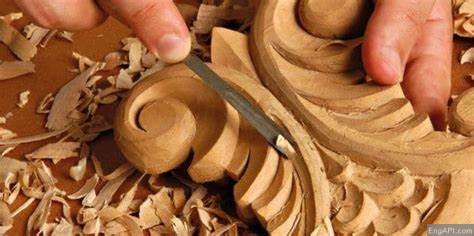

carve
音标:
英音/ kɑːv / 美音/ kɑːrv /
听听基本释意:
外刊例句:
It is a very high silt-yielding river given the steepness of the mountains it flows through and the force it has, allowing it to carve off so much rock and soil on its way.
这是一条产泥量非常高的河流,因为它所流经的山脉十分陡峭,而且它所具有的力量使它能够在途中冲刷掉如此多的岩石和土壤。
—BBC
A couple overseeing the £11m restoration of a derelict Welsh manor house have appealed for information about two carved wooden angels found at the property.
一对夫妇负责监督一座废弃威尔士庄园耗资 1100 万英镑的修复工程,他们呼吁提供有关在该庄园发现的两个木雕天使的信息。
—BBC
But this conference is also about carving out dividing lines with Labour, which won a huge majority in the general election.
但这次会议也是为了与在大选中赢得绝大多数的工党划清界限。
—BBC
基本释意:
none
none
雕,刻;切下,割下;开创,赢得(carve out);铺(路),修(路);侵蚀,冲刷;减少,削减
同义词:
没有找到同义词
短释义:
You might carve your initials into the tree in your backyard, or carve a walking stick out of a large branch. Some artists work by carving shapes from clay or granite, and a chef learns to carve, or precisely cut up, large cuts of meat and poultry. The Old English root word is ceorfan, “to cut, slay, carve, or engrave.”
当您将设计切割成一块木头或大理石时,您就完成了雕刻。墓碑雕刻师将人们的名字及其出生和死亡日期雕刻在墓碑上。
长释义:
You might carve your initials into the tree in your backyard, or carve a walking stick out of a large branch. Some artists work by carving shapes from clay or granite, and a chef learns to carve, or precisely cut up, large cuts of meat and poultry. The Old English root word is ceorfan, “to cut, slay, carve, or engrave.”
您可以将您名字的首字母刻在后院的树上,或者用一根大树枝刻一根手杖。一些艺术家用粘土或花岗岩雕刻形状,厨师则学习雕刻或精确切割大块肉类和家禽。古英语词根是 ceorfan,意思是“切割、杀戮、雕刻或雕刻”。
文学例句:
“Not the gingerbread you eat. Gingerbread is the name for the carving and scrollwork that decorated the hulls of pirate ships,” said Mom.
“不是你吃的姜饼。姜饼是装饰海盗船船体的雕刻和涡卷的名字。”妈妈说。
—Caterpillar Summer by Gillian McDunn
She patted her chest, the carved medallion of her parents’ faces tucked just beneath her shirt.
她拍拍自己的胸口,她父母头像的雕刻徽章就藏在衬衫下面。
—The Marvellers by Dhonielle Clayton
I hurried down a set of stone steps into a quiet sunken courtyard and pushed open a carved oak door.
我匆匆走下一段石阶,走进一个安静的下沉式庭院,推开一扇雕花橡木门。
—The Light in Hidden Places by Sharon Cameron
词源:
carve (v.)Middle English kerven (the initial -k- is from influence of Scandinavian forms), from Old English ceorfan (class III strong verb; past tense cearf, past participle corfen) “to cut,” also “cut down, slay; cut out,” from West Germanic *kerbanan (source also of Old Frisian kerva, Middle Dutch and Dutch kerven, German kerben “to cut, notch”), from PIE root *gerbh- “to scratch,” making carve the English cognate of Greek graphein “to write,” originally “to scratch” on clay tablets with a stylus.
Once extensively used and the general verb for “to cut;” most senses now have passed to cut (v.) and since 16c. carve has been restricted to specialized senses such as “cut (solid material) into the representation of an object or a design” (late Old English); “cut (meat, etc.) into pieces or slices” (early 13c.); “produce by cutting” (mid-13c.); “decorate by carving” (late 14c.). Related: Carved; carving. The original strong conjugation has been abandoned, but archaic past-participle adjective carven lingers poetically.Related entries & more
下面是词源的翻译(机器翻译比较难翻,参考着看)
carve (v.)中古英语 kerven(词首 -k- 受斯堪的纳维亚形式的影响),源自古英语 ceorfan(第三类强动词;过去式 cearf,过去分词 corfen)“切割”,也“砍下, slay; cut out,”源自西日耳曼语 *kerbanan(也源自古弗里斯兰语 kerva、中古荷兰语和荷兰语 kerven,德语 kerben “切割、刻痕”),源自 PIE 词根 *gerbh-“从头开始”,使 carve 成为英语希腊语石墨烯的同源词“书写”,最初是“用手写笔在粘土板上刮擦”。曾经被广泛使用,是“切割”的一般动词。大多数感官现在已经过去了(v.)并且自16c以来。雕刻仅限于特殊的含义,例如“将(固体材料)切割成物体或设计的表示”(晚期古英语); “将(肉等)切成块或片”(13世纪初期); “通过切割生产”(13世纪中期); “雕刻装饰”(14世纪末)。相关:雕刻;雕刻。原来的强烈词形变化已被放弃,但古老的过去分词形容词 carven 诗意地徘徊。相关条目及更多
本站没有存储任何书籍、杂志和报纸。
页面内容只做展示和推荐。如果您喜欢本期内容请购买正版。
This site does not store any books, magazines or newspapers.
The contents of the pages are for display and recommendation only.
If you like the content of this issue please purchase the original.